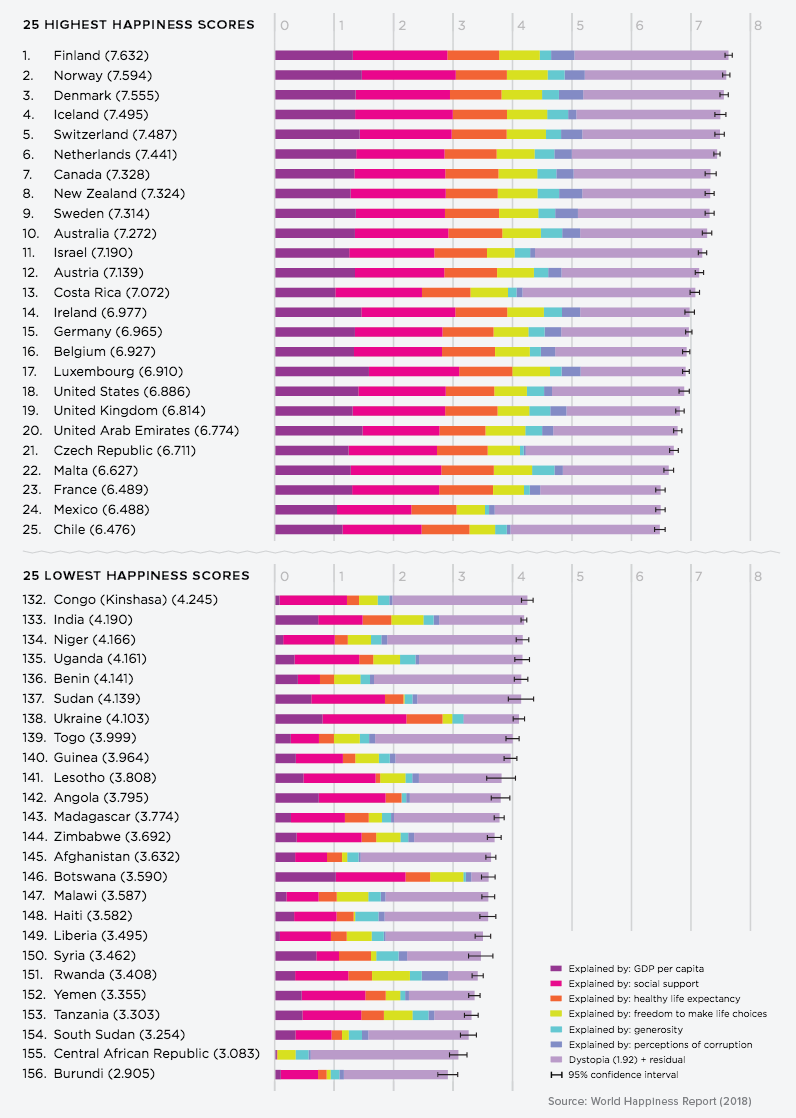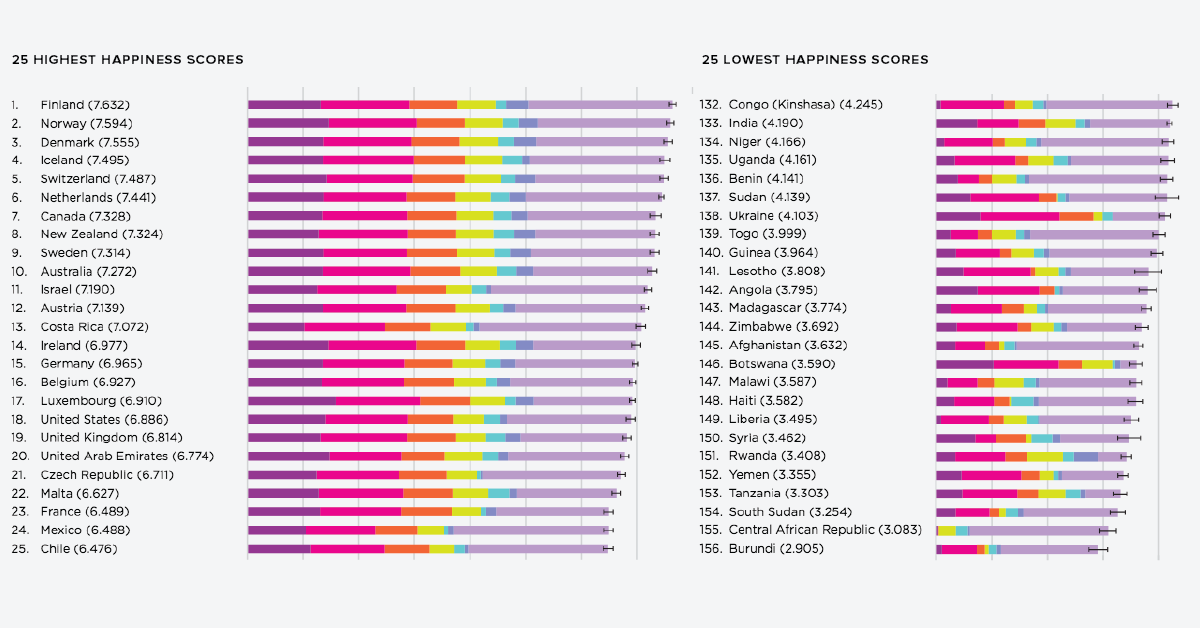Misc
Global Happiness: Which Countries are the Most (and Least) Happy?
Check out the latest 2023 update of the Global Happiness Index.
How much happier would you be if were given a 10% raise?
While money can be a crucial indicator of happiness at lower income levels, studies have found that as incomes rise, money becomes a less important part of the overall happiness equation.
In fact, researchers see happiness as a complex measure that involves many variables outside of material wealth, including social support, freedom, and health.
Measuring Global Happiness
Today’s chart uses data from the World Happiness Report 2018 to measure and understand which countries report feeling the most and least happy.

What Contributes to Happiness?
The six key variables used by researchers in this report on global happiness include:
- GDP per capita
- Healthy life expectancy
- Social support
- Freedom of choice
- Generosity
- Perceptions of corruption
While average income and life expectancy definitely carry their weight in explaining happiness levels, what’s more interesting are the Gallup World Poll (GWP) questions about the other, more subjective variables.
- Social support
“If you were in trouble, do you have relatives or friends you can count on to help you whenever you need them?” - Freedom to make life choices
“Are you satisfied or dissatisfied with your freedom to choose what you do with your life?” - Generosity
“Have you donated money to a charity in the past month?” - Perceptions of corruption
“Is corruption widespread throughout the government or not?”
“Is corruption widespread within businesses or not?”
How Happy is the World?
The top tier of happiest countries happen to be Nordic, with Finland, Norway, Denmark, and Iceland making it into the top five. Aside from having a common geographic location, these countries are also well-known for their social safety nets, using a high tax burden to fund government services such as education and healthcare.
A surprising entry near the top of the list might be Costa Rica. It’s the happiest country in the Latin American region, despite persisting income inequality issues. Although it has a lower GDP per capita than other high-ranking entries, the country has more than made up for it through social support; Costa Rica has invested significantly in education and health as a proportion of GDP, and the nation is also known for housing a culture that forms solid social networks of friends, families and neighborhoods.
On the other hand, 18 of the least happy countries are concentrated on the African continent. GDP per capita varies intensely among the bottom countries, and many report a lack of freedom overall. A silver lining is that social support is relatively stable, and there have been steady improvements over time.
Finally, the aftermath of the 2008 financial crisis has had a ripple effect on global happiness. The report demonstrates where the most and fewest advances have been made.
- Togo
Happiness is on the upswing, as the West African nation climbs 17 places to demonstrate the most improvement. - Venezuela
Meanwhile, the South American country plummeted even further, in part from socio-political changes and dramatic hyperinflation.
Where does your country fare on this scale?

Eudaimonia [happiness] is the meaning and the purpose of life, the whole aim and end of human existence.
― Aristotle
VC+
VC+: Get Our Key Takeaways From the IMF’s World Economic Outlook
A sneak preview of the exclusive VC+ Special Dispatch—your shortcut to understanding IMF’s World Economic Outlook report.

Have you read IMF’s latest World Economic Outlook yet? At a daunting 202 pages, we don’t blame you if it’s still on your to-do list.
But don’t worry, you don’t need to read the whole April release, because we’ve already done the hard work for you.
To save you time and effort, the Visual Capitalist team has compiled a visual analysis of everything you need to know from the report—and our VC+ Special Dispatch is available exclusively to VC+ members. All you need to do is log into the VC+ Archive.
If you’re not already subscribed to VC+, make sure you sign up now to access the full analysis of the IMF report, and more (we release similar deep dives every week).
For now, here’s what VC+ members get to see.
Your Shortcut to Understanding IMF’s World Economic Outlook
With long and short-term growth prospects declining for many countries around the world, this Special Dispatch offers a visual analysis of the key figures and takeaways from the IMF’s report including:
- The global decline in economic growth forecasts
- Real GDP growth and inflation forecasts for major nations in 2024
- When interest rate cuts will happen and interest rate forecasts
- How debt-to-GDP ratios have changed since 2000
- And much more!
Get the Full Breakdown in the Next VC+ Special Dispatch
VC+ members can access the full Special Dispatch by logging into the VC+ Archive, where you can also check out previous releases.
Make sure you join VC+ now to see exclusive charts and the full analysis of key takeaways from IMF’s World Economic Outlook.
Don’t miss out. Become a VC+ member today.
What You Get When You Become a VC+ Member
VC+ is Visual Capitalist’s premium subscription. As a member, you’ll get the following:
- Special Dispatches: Deep dive visual briefings on crucial reports and global trends
- Markets This Month: A snappy summary of the state of the markets and what to look out for
- The Trendline: Weekly curation of the best visualizations from across the globe
- Global Forecast Series: Our flagship annual report that covers everything you need to know related to the economy, markets, geopolitics, and the latest tech trends
- VC+ Archive: Hundreds of previously released VC+ briefings and reports that you’ve been missing out on, all in one dedicated hub
You can get all of the above, and more, by joining VC+ today.
-

 Debt1 week ago
Debt1 week agoHow Debt-to-GDP Ratios Have Changed Since 2000
-

 Markets2 weeks ago
Markets2 weeks agoRanked: The World’s Top Flight Routes, by Revenue
-

 Countries2 weeks ago
Countries2 weeks agoPopulation Projections: The World’s 6 Largest Countries in 2075
-

 Markets2 weeks ago
Markets2 weeks agoThe Top 10 States by Real GDP Growth in 2023
-

 Demographics2 weeks ago
Demographics2 weeks agoThe Smallest Gender Wage Gaps in OECD Countries
-

 United States2 weeks ago
United States2 weeks agoWhere U.S. Inflation Hit the Hardest in March 2024
-

 Green2 weeks ago
Green2 weeks agoTop Countries By Forest Growth Since 2001
-

 United States2 weeks ago
United States2 weeks agoRanked: The Largest U.S. Corporations by Number of Employees













